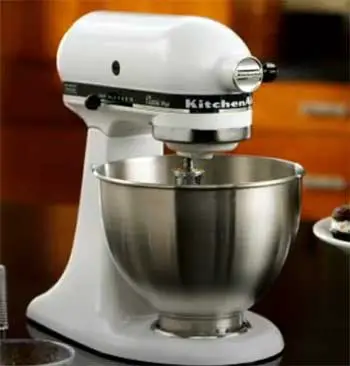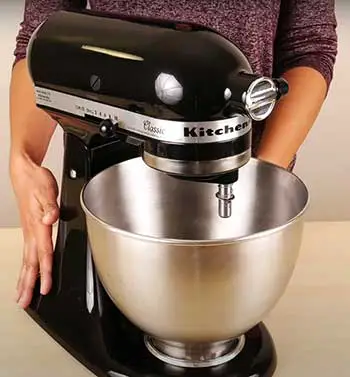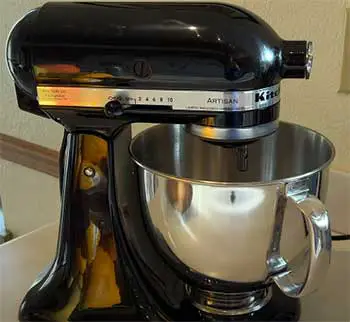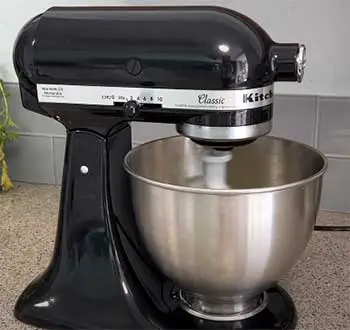If you love to bake, a stand mixer is an invaluable kitchen tool that can knead, whip, and mix ingredients with power and precision, saving you time and effort. KitchenAid makes some of the best stand mixers, but with so many models available, deciding between the Ultra Power and the Classic can get confusing.
I compared the key features side-by-side to help you determine which of these popular KitchenAid mixers is the right fit for your baking needs and budget.
KitchenAid Stand Mixer Comparison
| Feature | Ultra Power | Classic |
| Motor Power | 325 Watts | 275 Watts |
| Speed Settings | 10 | 10 |
| Bowl Capacity | 5 Quart | 4.5 Quart |
| Weight | 9 lbs | 18 lbs |
| Dimensions | 8.7 x 7.7 x 12.7 in | 9.3 x 14 x 14 in |
| Included Accessories | Coated flat beater<br>Coated dough hook<br>6-wire whisk | Coated flat beater<br>Coated dough hook<br>6-wire whisk |
Looking at the stats, the Ultra Power has a more powerful motor at 325 Watts vs 275 Watts on the Classic and holds slightly more at 5 Quarts compared to 4.5 Quarts. However, there are some key similarities too – both have 10 speed settings and come with the same 3 core accessories.
Where they differ is on weight, dimensions and price. Keep reading as I expand on the pros, cons and key differences between the two to help you decide.
Overview of the KitchenAid Ultra Power Stand Mixer
The KitchenAid Ultra Power stand mixer packs a lot of features and power into a compact size.

Weighing in at just 9 pounds, it’s much lighter than the Classic model.
The lightweight design makes it easier to move the mixer in and out of storage.
Despite being the lighter model, the Ultra Power doesn’t compromise on performance thanks to its 325 Watt motor.
It mixes up to 9 dozen cookies in a single batch. The 5 quart stainless steel mixing bowl gives you 1/2 a quart more capacity than the Kitchen classic.
Between the bowl size and power, the Ultra Power handles doubling recipes with ease.
Ten precise speeds give you mixing versatility – from a slow stir to a fast whip. No matter what you’re mixing up, a slide control allows you to easily select the right speed. The mixer comes with a flat beater, dough hook, and wire whip to handle all your mixing tasks.
A tilt-head design allows you to easily access the bowl and change attachments. The Ultra Power securely locks the bowl in place while operating to prevent messes. Once you’re done mixing, you can stow the mixer upright to minimize storage space.
With impressive power and thoughtful design in a compact size, the Ultra Power gives you professional-quality performance without taking up your whole counter.
Overview of the KitchenAid Classic Stand Mixer
As the name implies, the KitchenAid Classic stand mixer delivers timeless quality and performance. Weighing in at a sturdy 18 pounds, this hefty mixer stays securely planted on your counter during intense mixing tasks.
While it only has a 275 Watt motor compared to the newer Ultra Power’s 325 Watts, it has plenty of strength to whip, knead, and mix batters. The 4.5 quart stainless steel mixing bowl handles medium to large batches with ease.

Like the Ultra Power, the KitchenAid Classic has 10 speeds to fine-tune mixing speed and performance.
It comes equipped with the same flat beater, dough hook, and wire whip to handle all types of recipes from bread doughs to silky frostings.
These core attachments are dishwasher-safe for easy cleanup.
The Classic has a tilt-head design to allow you to access the bowl.
However, the mixing bowl locks into place by twisting into position for added security compared to the Ultra Power’s lift-to-lock bowl.
After decades of performance, the KitchenAid Classic mixer maintains popularity thanks to its versatile functionality and durability. While it comes at a more affordable price point than other KitchenAid models, the Classic doesn’t compromise on delivering quality results.
Standout Features of Ultra Power And Classic Mixers
Beyond the core stats, here are some key points that differentiate the Ultra Power and Classic KitchenAid stand mixers:
Motor Power
- The Ultra Power has a more powerful 325 Watt motor compared to the Classic’s 275 Watts. The extra motor strength allows it to power through thick batters and double recipes with less strain.
Weight and Portability
- Weighing just 9 pounds, the Ultra Power is much lighter and easier to move around the kitchen compared to the hefty 18 pound Classic.
Bowl Capacity
- With a 5 quart capacity, the Ultra Power holds 10% more than the Classic’s 4.5 quart mixing bowl.
Dimensions
- Both models have similar width and depth, but the Classic is 2 inches taller. The Ultra Power’s low profile design saves precious storage space.
Included Accessories
- Both mixers come with coated versions of the flat beater, dough hook and wire whip to withstand abrasive ingredients. The accessories are interchangeable between models.
Price
- With simpler construction focused just on excellent performance, the Classic model comes at a more budget-friendly price point than the Ultra Power.
Now that you know how they stack up by the specs and features, let’s compare them across some key factors.
Power and Performance Comparison

When it comes to mixing performance, both these KitchenAid models deliver quality results.
However, the Ultra Power’s extra motor power gives it an edge in muscle for heavy mixes.
The Ultra Power’s 325 Watt motor handles thick cookie doughs and double batches better than the Classic model.
While the Classic mixer isn’t underpowered by any means, the strain shows quicker when mixing heavier loads.
Both models include 10 speed settings for fine-tuned control. Whether you’re mixing up a light meringue or heavy bread dough, you can dial in the right speed.
The Ultra Power feels snappier accelerating to higher speeds whereas the Classic has a subtle lag. For most recipes, either stand mixer provides enough power and precision. But the Ultra Power’s superior torque makes it the winner if you regularly double recipes or mix dense doughs.
Size and Capacity Comparison
When it comes to capacity and size, the Ultra Power again inches out a win. Its compact footprint fits better in tight storage spaces while delivering 10% more bowl capacity than the Classic.
Both models are equipped with quality stainless steel mixing bowls. But the Ultra Power’s 5 quart capacity handles bigger batches better. An extra 1⁄2 quart capacity might not seem like much, but it makes fitting double batches less cramped.
While the Classic model is 2 inches taller, the Ultra Power and Classic have similar width and depth. I found the Ultra Power’s low profile shape makes it easier to stash under cabinets compared to the Classic.
So if you’re tight on space or regularly mix large batches, the Ultra Power gets the edge for capacity and storage. But the Classic’s mid-size bowl still holds enough for most home bakers.
Attachments and Accessories
When it comes to included attachments, both the Ultra Power and Classic come ready to mix with:
- Coated Flat Beater
- Coated Dough Hook
- 6-Wire Whip
These core accessories equip you to mix, knead, and whip ingredients for everything from breads to frostings. The nylon coating prevents abrasions from coarse mixes like dense dough.
Both models use the same easy tilt-head release to lower the mixer head and access the bowl. But the Classic twists the bowl into place compared to the Ultra Power’s lift-to-lock system.
I found the Ultra Power’s release easier for quickly removing the bowl while the Classic bowl stays locked more securely mid-mix. But either mixing bowl remains solidly in place while operating despite the differing release methods.
One advantage of KitchenAid stand mixers is the wide range of optional attachments available to expand functionality like pasta rollers, juicers and more. All optional attachments work interchangeably between the Ultra Power and Classic models.
When it comes to included accessories and attachments, performance is equal. Both models provide the core essentials while offering attachment flexibility.
Easy to Use and Clean
From mixing to cleaning up, both the Ultra Power and Classic models are designed for simplicity.

A single slide lever allows you to smoothly shift between the 10 speeds settings.
Dialing in the right mixing intensity for recipes feels seamless.
Compared to the Classic, I felt the Ultra Power responded quicker accelerating through the speeds thanks to the extra motor power.
Both mixers use a simple tilt-head design to lower the mixing head and access the bowl easily.
While their release methods differ slightly, attaching and removing the bowl is straightforward with either model.
All included attachments and mixing bowls cleanly wipe down or hold up in the dishwasher. The accessories are made from dishwasher-safe metal and coated nylon. For convenience, I appreciate how compactly the Ultra Power stores upright to minimize dust.
While the Classic’s heavier build holds it steadier mid-mix, I give the Ultra Power the advantage for conveniently moving and storing away this appliance after each use thanks to its lighter body. Otherwise, both models deliver on easy operation and maintenance.
Reliability and Warranty
KitchenAid built its reputation on durable products backed by strong warranties. When it comes to reliability and warranty coverage, both the Ultra Power and Classic deliver quality and support.
The Classic model establishes itself as the gold standard for enduring performance. Weighing in at a sturdy 18 pounds, this stand mixer stays grounded through intense mixing tasks. Some Classic mixers continue running flawlessly for over a decade.
Meanwhile, the Ultra Power’s impressive 5 year warranty confirms its reliability. KitchenAid stands behind this modern, lightweight model to function smoothly trip after trip.
Both mixers carry a 1 year replacement warranty. KitchenAid also backs all included accessories with a standard 1 year warranty.
Given their reputations and excellent warranty coverage, either the Classic or Ultra Power KitchenAid stand mixer makes a lasting investment for aspiring home bakers.
You can trust years of enjoyable mixing adventures with either model. The Ultra Power holds an edge for its 5 year warranty period over the Classic model.
Affordability
The Classic stand mixer clearly wins when it comes to budget-friendliness. With a simpler, mid-century design focused on utility over features, the Classic model costs significantly less than the Ultra Power.
As KitchenAid’s standard affordable model for decades, the Classic regularly costs $100+ less than the Ultra Power. For shoppers on a tight budget, the Classic hits the sweet spot of performance at a pleasing price point.
Meanwhile, the Ultra Power justified its launch as a modern, lightweight mixer alternative to pricier KitchenAid options. By integrating top-tier power into a compact build, it carved out an appealing mid-range niche above the Classic baseline model.
Either model makes a worthy mixer investment for years of reliable service. But if you’re bargain hunting for a capable mixer on a budget, I recommend snagging the well-proven Classic model. More features never hurts, but casual home bakers get along fine without the Ultra Power’s extras.
Style and Design
Style preference splits more subjectively between the retro Classic and streamlined Ultra Power aesthetic.
The Classic channels 1950’s charm with its larger rounded shape and utilitarian details. Available in a range of muted, vintage-inspired metallic hues, the Classic comfortably blends into most kitchen decors. The iconic polished bowl and busy accessory hub looks reassuringly purpose-built.
Meanwhile, the Ultra Power modernizes the classic stand mixer silhouette with strategically pared back shaping. The smoothly rounded head and slim base strike an elegant profile. Sleek controls and a spare accessory hub simplify the design. It pops nicely against cabinets in bold modern hues like empire red.
So whether your kitchen leans traditional or contemporary, both models bring visual appeal to the countertop. The Ultra Power looks tidier thanks to smart storage and smoother finishes. But you can’t beat the charming utilitarian vibe of the Classic model.
Stand Mixer Uses
Stand mixers excel at efficiently powering through mixing tasks from batters to doughs. Both the Classic and Ultra Power handle core mixing jobs for baking like:
- Cookie dough
- Cakes and frostings
- Quick breads
- Yeast doughs like pizza and bread
- Meat mixes like meatballs
- Whipping cream
Optional attachments like food grinders, pasta rollers and spiralizers expand functionality beyond mixing. Either model pairs with KitchenAid’s broad attachment ecosystem. So no matter which mixer you choose, you open endless creative possibilities baking and cooking.
For most common recipes, the Classic and Ultra hold their own. But the Ultra Power’s extra muscle helps it muscle through dense mixes and large batches better.
Both models have limitations handling ultra-thick mixes like nut butters or tiny volumes like a single egg white. For extreme loads better suited to commercial equipment, KitchenAid’s Pro Line 600 series mixers fill that role.
Within normal home baking limits though, the Classic and Ultra Power mixers deliver consistent, quality results meal after meal. You can count on either appliance for an essential spot on your kitchen counter.
Frequently Asked Questions (FAQ)
The main differences are:
Power: The Ultra Power has a 325 Watt motor while the Classic has 275 Watts
Weight: The Ultra Power weighs 9 lbs vs 18 lbs for the Classic
Bowl Size: 5 quart for Ultra Power vs 4.5 quart for Classic
Dimensions: The Ultra Power has a lower profile at 8.7 x 7.7 x 12.7 in vs 9.3 x 14 x 14 in for the Classic
Warranty: Ultra Power has 5 years vs 1 year for Classic
Price: The Ultra Power costs more than the Classic
So in summary, the Ultra Power is lighter, more powerful, larger capacity and has a better warranty, while the Classic is more budget-friendly.
KitchenAid Ultra Power is one of KitchenAid’s stand mixer models. Key features include:
325 Watt motor (more power than Classic)
Lightweight at 9 lbs
5 quart stainless steel mixing bowl
10 precise speeds
Tilt-head design
Comes with coated flat beater, dough hook and wire whip
5 year warranty
It delivers robust power and capacity in a compact build. The Ultra Power fills the gap between the Classic and more expensive Artisan lines.
The Ultra Power and Artisan lines offer similar power with some key differences:
Power: Artisan has 325 Watts like Ultra Power
Bowl: Both have 5 quart capacity
Controls: Artisan has touch controls vs slide control for Ultra Power
Design: Artisan has a sleeker polished metal design and tilting touchscreen
Weight: Artisan is heavier at 14 lbs vs 9 lbs for Ultra Power
Warranty: Artisan includes 10 years vs 5 years with Ultra Power
Price: Artisan costs $100+ more than Ultra Power
So Artisan delivers extra styling and convenience features at a higher price point compared to Ultra Power’s streamlined power. But the Ultra Power includes the same mixing muscle and bowl capacity for less.
The main differences between the Classic and Artisan KitchenAid stand mixers are:
Power: Artisan has 325 Watts vs 275 Watts in Classic model
Bowl size: Artisan has a 5 quart bowl vs 4.5 quarts for Classic
Controls: Artisan features an intuitive touch interface compared to the slide lever speed control on the Classic
Design: Artisan styling is rounded with a polished metal finish compared to Classic’s utilitarian look
Weight and size: The Artisan mixer has a larger footprint at 14 lbs and taller height than the Classic
Warranty: Artisan includes 10 years versus just 1 year for the Classic model
Price: Artisan costs over $100 more than the affordable Classic model
In summary – the Artisan upgrades power, controls, looks and warranty over the Classic workhorse. But the Classic continues offering solid functionality if you don’t need premium features.
Closing Remarks
After taking a deep dive into specs and real customer experiences using both appliances, here are the key takeaways on how the Ultra Power and Classic KitchenAid stand mixers compare:
- The Ultra Power delivers more power and faster higher speeds thanks to its 325 Watt motor versus 275 Watts in the Classic model.
- Weighing nearly half as much as the Classic, the Ultra Power mixer is far more portable and convenient to store.
- While the Ultra Power holds over 10% more in its 5 quart bowl, the Classic’s 4.5 quarts still easily accommodates most family recipes.
- Both models include the core accessories for mixing and kneading tasks. All KitchenAid attachments work interchangeably between them as well.
- The Ultra Power justifies a higher price with more power and capacity. Meanwhile the Classic keeps budget friendly appeal.
- Backed by 1+ year warranties, both heavy-duty mixers deliver lasting quality.
If your budget allows, the Ultra Power makes a sensible upgrade over the Classic model. But casual home bakers thoroughly enjoy the simpler Classic too. Let your counter space, recipe loads, and budget guide you.
I hope mapping out the KitchenAid Ultra Power vs Classic stand mixers in detail helps steer you toward the perfect model for your needs! Let me know if you have any other questions.

I cannot find this ultra power kitchen aid stand mixer that only weighs 9# and smaller dimensions w a 325 motor. Can you give me the site I can purchase this plz and the cost.